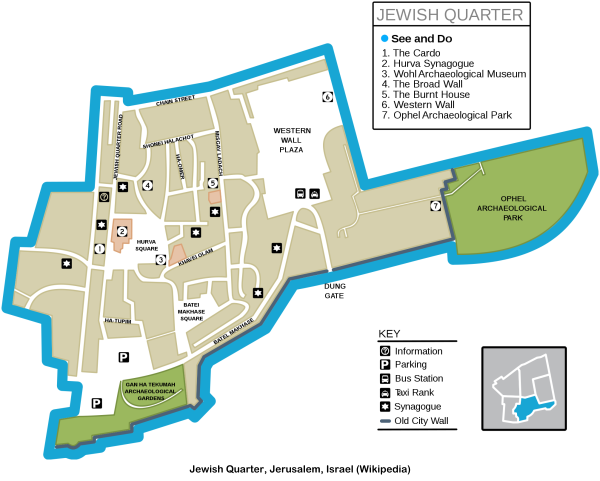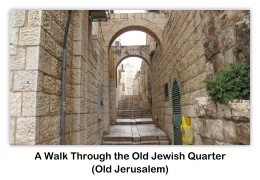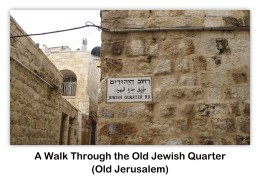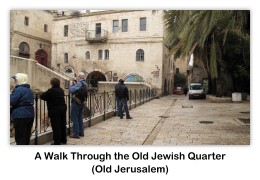

 |
 |
 |
Old Jewish Quarter
Israel, Jerusalem, 3 March 2009
Overview
On 3 March 2009, Carol and John embarked on a walking tour of Jerusalem. We were part of a Grand Circle Tours group that visited, Israel, Egypt and Jordan. Upon departing from our bus, we were greeted by a slow drizzle. With cameras and umbrellas in hand we passed by and visited many of Jerusalem's historic sites. The Old Jewish Quarter was one of these sites.
The following photos were taken during that visit with a Canon G.10 “PowerShot” 14.7 megapixel camera. Behind the majority of the thumbnail photos shown below is a full-size (4,416 × 2,480 pixel) 16:9 HD formatted photo. A few of the photos had been straightened and cropped. Although copyrighted © by Skytamer Images, none of the photos contain messy copyright notices. They all look like they came straight out of your camera … Enjoy! These photos are for your personal use only, and are not to be used for commercial purposes without written permission from Skytamer Images.

Old Jewish Quarter
The Jewish Quarter is one of the four traditional quarters of the Old City of Jerusalem. The 45,000 square meter area lies in the southeastern sector of the walled city, and stretches from the Zion Gate in the south, along the Armenian Quarter on the west, up to the Cardo in the north and extends to the Western Wall and the Temple Mount in the east.







The quarter has had a rich history, with a nearly continual Jewish presence since the eighth century BCE. At the turn of the 20th century the Jewish population of the quarter reached 19,000. At no time was its population purely and homogeneously Jewish - such a rule being neither desired by the Jewish inhabitants nor enforced by the Ottoman or British rulers; in fact, there had always been a considerable non-Jewish population living among its Jews.
In 1948 during the Arab-Israeli War, its population of about 2,000 Jews was besieged, and forced to leave en masse. Colonel Abdullah el Tell, local commander of the Jordanian Arab Legion, with whom Mordechai Weingarten negotiated the surrender terms, described the destruction of the Jewish Quarter, in his Memoirs (Cairo, 1959):
“ … The operations of calculated destruction were set in motion. … I knew that the Jewish Quarter was densely populated with Jews who caused their fighters a good deal of interference and difficulty. … I embarked, therefore, on the shelling of the Quarter with mortars, creating harassment and destruction. … Only four days after our entry into Jerusalem the Jewish Quarter had become their graveyard. Death and destruction reigned over it. … As the dawn of Friday, May 28, 1948, was about to break, the Jewish Quarter emerged convulsed in a black cloud - a cloud of death and agony.”
Yosef Tekoah (Permanent Representative of Israel to the United Nations) quoting Abdullah el-Tal, The Jordanian commander who led the operation is reported to have told his superiors:
“For the first time in 1,000 years not a single Jew remains in the Jewish Quarter. Not a single building remains intact. This makes the Jews' return here impossible.”
The quarter remained under Jordanian rule until its capture by Israel during the Six-Day War of 1967. During the 1960s American town planners, together with the Jordanian authorities, had planned that the quarter be transformed into a park. During the nineteen year Arab administration, a third of the Jewish Quarter's buildings had been demolished by the Jordanians. All but one of the thirty-five Jewish houses of worship that graced the Old City were wantonly destroyed. The synagogues were razed or pillaged and stripped and their interiors used as hen-houses or stables. The Western Wall, one of the most sacred sites in Judaism, was used as a garbage dump. Tombstones were used as paving stones.
In 1969 the Jewish Quarter Development Company was established under the auspices of the Construction and Housing Ministry to rebuild the desolate Jewish Quarter. At this stage the Arab population of the Quarter reached approximately 1,000, most of whom were refugees who had appropriated the vacated Jewish houses in 1949. Although many had originally fled the Quarter in 1967, they later returned after Levi Eshkol ordered that the Arab residents not be forcefully evacuated from the area. With Menachem Begin's rise to power in 1977, he decided that 25 Arab families be allowed to remain in the Jewish Quarter as a gesture of good will, while the rest of the families who had not fled during the Six-Day War were offered compensation in return for their evacuation, although most declined. The quarter was rebuilt in keeping with the traditional standards of the dense urban fabric of the Old City. Residents of the quarter hold long-term lease-holds, leased from the Israel Lands Administration. As of 2004 the quarter's population stood at 2,348 and many large educational institutions have taken up residence.
Before being rebuilt, the quarter was carefully excavated under the supervision of Hebrew University archaeologist Nahman Avigad. The archaeological remains, on display in a series of museums and outdoor parks to visit which tourists descend two or three stories beneath the level of the current city, collectively form one of the world's most accessible archaeological sites.
The most famous site of the Jewish Quarter is The Western Wall, ha-kotel ha-ma'aravi in Hebrew, the only surviving portion of the retaining wall around the Temple of Jerusalem. It consists of huge ashlar blocks that have been in place for two millennia. It is a major site for pilgrimage for Jewish people from all over Israel and all over the world. It is also a major tourist attraction for people of all faiths. Visitors insert handwritten prayers into the interstices between the stones. Pious men continually read the entire book of Psalms in front of the wall. Bar Mitzvahs are joyfully celebrated here.
Next to the Wall is a huge plaza, covering a substantial portion of the Jewish Quarter, allowing worshipers and visitors a good view of the Wall and access to it. The plaza has no art works or monuments.
The Skytamer Archive
This concludes our visit to the Old Jewish Quarter in Jerusalem, Israel. To learn more about the Mount of Olives, visit the Wikipedia site noted below. Please remember that the photos used on this webpage are copyrighted © by Skytamer Images, and are for your personal use only. Commercial use of these images requires written permission from Skytamer Images.
References
- Shupek, John, “Skytamer Images Photo Archive”
- Google Earth, “Satellite Image”
- Wikipedia, Mount of Olives
Copyright © 1998-2019 (Our 21st Year) Skytamer Images, Whittier, California
All rights reserved


























